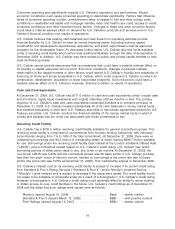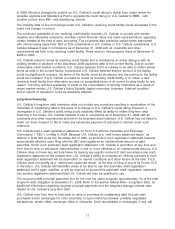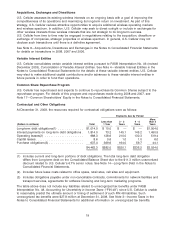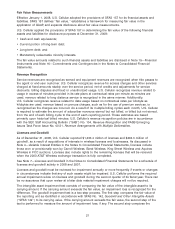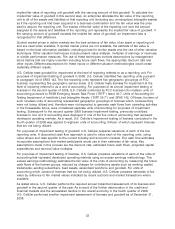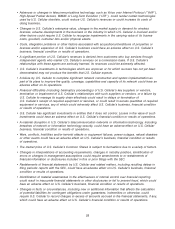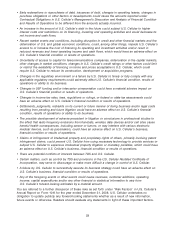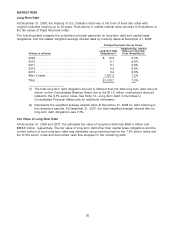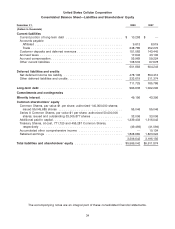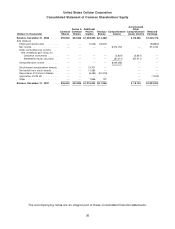US Cellular 2008 Annual Report Download - page 148
Download and view the complete annual report
Please find page 148 of the 2008 US Cellular annual report below. You can navigate through the pages in the report by either clicking on the pages listed below, or by using the keyword search tool below to find specific information within the annual report.Under the provisions of SFAS 123(R), stock-based compensation cost recognized during the period is
based on the portion of the share-based payment awards that are expected to ultimately vest. The
estimated forfeiture rates used by U.S. Cellular are based primarily on historical experience.
Total compensation cost for stock options granted by U.S. Cellular in 2008 was estimated to be
$7.8 million; the amount charged to expense in 2008 was $4.7 million. A 10% change in any one of the
2008 assumptions related to expected life, expected volatility, or risk-free interest rate would affect the
total compensation cost of $7.8 million by less than $1.0 million.
Contingencies Indemnities and Commitments
Contingent obligations not related to income taxes, including indemnities, litigation and other possible
commitments are accounted for in accordance with SFAS No. 5, Accounting for Contingencies
(‘‘SFAS 5’’), which requires that an estimated loss be recorded if it is probable that an asset has been
impaired or a liability has been incurred at the date of the financial statements and the amount of the
loss can be reasonably estimated. Accordingly, those contingencies that are deemed to be probable and
where the amount of the loss is reasonably estimable are accrued in the financial statements. If only a
range of loss can be determined, the best estimate within that range is accrued; if none of the estimates
within that range is better than another, the low end of the range is accrued. Disclosure of a contingency
is required if there is at least a reasonable possibility that a loss has been incurred, even if the amount is
not estimable. The assessment of contingencies is a highly subjective process that requires judgments
about future events. Contingencies are reviewed at least quarterly to determine the adequacy of accruals
and related financial statement disclosures. The ultimate outcomes of contingencies could differ
materially from amounts accrued in the financial statements.
CERTAIN RELATIONSHIPS AND RELATED TRANSACTIONS
U.S. Cellular is billed for all services it receives from TDS pursuant to the terms of various agreements
between U.S. Cellular and TDS. The majority of these billings are included in U.S. Cellular’s Selling,
general and administrative expenses. Some of these agreements were established prior to U.S. Cellular’s
initial public offering, when TDS owned more than 90% of U.S. Cellular’s outstanding capital stock, and
may not reflect terms that would be obtainable from an unrelated third party through arms-length
negotiations. Billings from TDS to U.S. Cellular are based on expenses specifically identified to
U.S. Cellular and on allocations of common expenses. Such allocations are based on the relationship of
U.S. Cellular’s assets, employees, investment in property, plant and equipment and expenses to the total
assets, employees, investment in property, plant and equipment and expenses of TDS. Management
believes that the method TDS uses to allocate common expenses is reasonable and that all expenses
and costs applicable to U.S. Cellular are reflected in U.S. Cellular’s consolidated financial statements.
Billings from TDS to U.S. Cellular totaled $113.3 million, $121.8 million and $108.9 million for 2008, 2007
and 2006, respectively.
The following persons are partners of Sidley Austin LLP, the principal law firm of U.S. Cellular and its
subsidiaries: Walter C.D. Carlson, a director of U.S. Cellular, a director and non-executive Chairman of
the Board of Directors of TDS and a trustee and beneficiary of a voting trust that controls TDS; William S.
DeCarlo, the General Counsel of TDS and an Assistant Secretary of TDS and certain subsidiaries of TDS;
and Stephen P. Fitzell, the General Counsel of U.S. Cellular and TDS Telecommunications Corporation
and an Assistant Secretary of U.S. Cellular and certain other subsidiaries of TDS. Walter C.D. Carlson
does not provide legal services to TDS, U.S. Cellular or their subsidiaries. U.S. Cellular and its
subsidiaries incurred legal costs from Sidley Austin LLP of $6.9 million in 2008, $6.6 million in 2007 and
$6.9 million in 2006.
The Audit Committee of the Board of Directors is responsible for the review and oversight of all related
party transactions, as such term is defined by the rules of the New York Stock Exchange.
26


